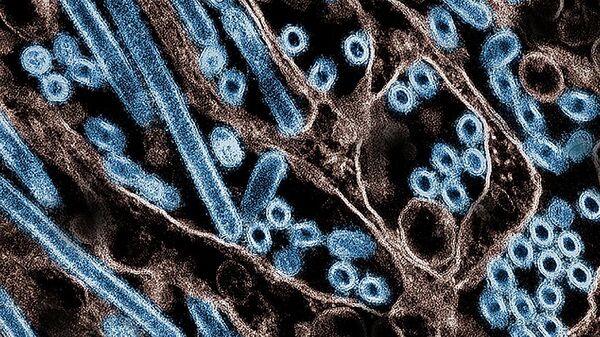(MENAFN- Live Mint) HMPV, or the Human Metapneumovirus, made headlines after Chinese state media reported that the HMPV virus was among other pathogens responsible for the uptick in infectious respiratory illnesses in the country. The reports sounded alarm in many countries, including India. Many compared this HMPV virus to the Coronavirus that triggered a pandemic in 2020. But is HMPV the same as the COVID-19 virus? Or, is it, in fact, different from it? Let's see the differences. Also Read | HMPV Cases LIVE: HMPV tally rises to 7, JP Nadda says 'not a new virus' What is HMPV and COVID-19The Human Metapneumovirus, commonly known as the HMPV, is a common respiratory virus first identified by Dutch scientists in the early 2000s. However, serological studies have shown that the virus has existed for at least 60 years and has spread all over the world as a common respiratory pathogen.
HMPV is a virus that causes respiratory illness, especially among those in the high-risk group (children, elderly, pregnant women and immunocompromised people).
Meanwhile, COVID-19 is a disease caused by the SARS-CoV-2 virus. Unlike COVID-19, HMPV does not have widespread name recognition.
Also Read | HMPV in India: How to recognise Covid-like pandemic? Are we prepared for it? HMPV vs COVID: How are they similar? 1. Both HMPV and SARS-CoV-2 cause infectious diseases. They are known to cause respiratory illness. Clinical features of HMPV and COVID-19 are difficult to distinguish from other viral illnesses.
2. Young children, the elderly, and people with weakened immune systems are likely to be at the highest risk. "In susceptible individuals with underlying medical conditions, HMPV infection can lead to death," China's Centers for Disease Control and Prevention (CDC said. COVID-19 led to the death of millions during the pandemic.
Also Read | HMPV cases in India: Is it new virus? Is there any vaccine? What we know so far 3. They are both communicable diseases. Infection from both viruses is transmitted through secretions from coughing, sneezing, and close personal contact with an infected person. The viruses also spread by touching contaminated objects or surfaces and then touching the mouth, nose, or eyes.
4. They are said to have seasonal infections. As per Science Direct, COVID-19 appears to be temperature-sensitive and, therefore, seasonal. Similarly, HMPV circulates in distinct annual seasons, the US CDC said.
5. Most methods to prevent the spread of HMPV infection and COVID-19 are the same. To effectively reduce the chance of infection, people are advised to wear masks when going to crowded places, wash hands frequently, stay in ventilation, and perform scientific disinfection.
6. Both HMPV and COVID-19 infections can be asymptomatic. According to research ,“Among the healthy elderly group, 16 of the 36 [HMPV] infections (44%) were asymptomatic, while 19 of 49 infections (39%) in the high-risk group were asymptomatic. The percentage of asymptomatic infection was even greater in the young group (27 of 38 infections [71%]).”
HMPV Vs Covid-19 symptoms: How are they different?The symptoms caused by the HMPV virus and the SARS-CoV-2 virus are similar. The most common symptoms of HMPV and COVID-19 include cough, fever, body aches, sore throat, nasal congestion, and shortness of breath. Those who develop serious complications may suffer from pneumonia.
However, people infected with COVID-19 show many more symptoms than those suffering from HMPV. The differences in symptoms are primarily seen in severe cases.
According to the China CDC, HMPV can sometimes result in bronchitis and pneumonia in severe cases. An article published by Apollo Hospital said ear infections may be reported, particularly among children.
Meanwhile, less common symptoms of COVID-19, according to the World Health Organisation (WHO), include loss of smell and taste, muscle aches and heavy arms or legs, severe fatigue or tiredness, runny or blocked nose, headache, sore eyes, dizziness, tight chest, chest pain, numbness or tingling and difficulty sleeping.
People with the following COVID-19 symptoms should seek immediate medical attention:
1. Difficulty breathing, especially at rest, or unable to speak full sentences
2. Confusion
3. Drowsiness or loss of consciousness
4. Persistent pain or pressure in the chest
5. Skin being cold or clammy, or turning pale or a bluish colour
6. Loss of speech or movement
Healthcare professionals may not routinely consider or test for HMPV.
How is HMPV infection different from COVID-19?While cases are climbing in China, the situation is very different from what it was when COVID-19 emerged five years ago, medical experts say. HMPV is common and decades old.
In China, the reports of respiratory infections in the past few days were attributed not only to HMPV but also to influenza.
Prof John Tregoning, Professor in Vaccine Immunology, Imperial College London, was quoted by Science Media Centre as saying, "It [HMPV] is part of the cocktail of winter viruses that we are exposed to."
China has also clarified,“Respiratory infections tend to peak during the winter season.”
In India, though a few cases have been reported, the Ministry of Health said it is closely monitoring the situation in China through all available channels and also requested the World Health Organization (WHO) to share timely updates regarding the situation.



















Comments
No comment